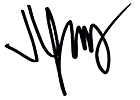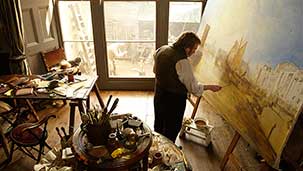Making great art about great art is always a precarious endeavor. Impossible, some might argue. Which is why so many films about the work of great artists fixate on process: the how, the where, the when—anything that can be quantified.
When it comes to the more subjective stuff – the art itself – a bit of ambiguousness is often necessary to maintain the illusion of sublimity. In Mr. Turner, you and your longtime collaborator, writer/director Mike Leigh, approach this dilemma in a rather unique way: by treating Turner’s great art like an element of set design or an object from the props department. It sits off-center, out-of-focus, setting a mood or invoking a feeling, but never fully occupying the foreground.
Your lush and languorous portrait of preeminent British painter JMW Turner has much in common with a painted portrait: it’s inert, fastidious, captivating. Turner, the man, occupies virtually every frame of the film: standing in silhouette as he sketches a crepuscular landscape; strolling along the beaches of Northern England; posing with deathly stillness for a daguerreotype. As embodied by Timothy Spall – who looks, here, like an Edward Gorey drawing of a Lewis Carroll character – he is a compelling presence, moving with a gorilla’s mean agility, speaking in a language of phlegmy growls and grunts.
His artwork is much less prominent. When we do see it, it’s usually from an oblique angle, or from afar, or partially obscured. When the art critic John Ruskin arrives with his father to inspect a painting, the camera stays behind the canvas, and we’re forced to conjure the image in our minds based only on Ruskin’s descriptive evangelizing. Never once do we get that intimate artist’s perspective; there are no loving close-ups of the brush wetly caressing the canvas, no balletic flurry of strokes set to inspiring music. There’s little magic in Turner’s creative process—at least not in the way you express it in this film. He spits and scrapes and blows powdered paint, and does it with the dispassion of a cobbler or cooper. Indeed, he seems to approach painting as a trade.
As cinematographer, you had to overcome a few dilemmas specific to your trade: how to shoot the vistas and landscapes that inspired Turner’s canvases. There is digital trickery involved, to be sure—in one scene, as Turner is paddling along the Thames with his artist pals, the reverse shot is a near-exact recreation of his painting “The Fighting Temeraire tugged to her last berth to be broken up.” The image is radiant, otherworldly, gorgeous, but has the peculiar effect of diminishing the resultant work of art; it makes the process seem too easy, too elementary, like a simple transposition of what Turner sees.
This is exactly the kind of misstep that you and Leigh so deftly avoid in so many other parts of the film. When Turner lashes himself to the mast of a ship in order to witness firsthand the eye of a storm, the camera doesn’t move from its fixed place in front of him. We see Turner, wild-eyed, pummeled by hailstones, but we never see what he sees. Later, as we see him swirling his brush to create the curling smoke plume at the center of “Snow Storm: Steam-Boat off a Harbour's Mouth”, we can easily make the connection between those two moments, and how one influenced the other.
Without additional historical context, one might leave the film feeling like Turner was a minor figure in Victorian art, and not, as he came to be known, one of the great masters of British landscape painting (he was known as the “Painter of Light” long before Thomas Kinkade trademarked that epithet to market his Disney-themed atrocities). Is it a failing of the film that Turner’s place in history is never quite established? That the evolution of his style, which, like the paintings he creates, occurs so subtly that it’s almost invisible?
No, not really. The film is purposely impressionistic in the same way that Turner’s later work veered towards (and in many ways prefigured) the principles and methods of the impressionism movement. One must keep in mind that you and Leigh are painting a portrait, not a landscape, and that everything on the periphery must stay there.
Great art is all about clarity of purpose, and it’s clear that, in shooting this film, you possessed it. Turner would surely offer a grunt of approval.
Sincerely,

Jared







